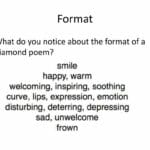Emily Dickinson, a reclusive and enigmatic poet of the 19th century, penned works that continue to resonate with contemporary readers due to their insightful exploration of complex themes. “Much Madness is divinest Sense,” arguably one of her most famous poems, delves into the paradoxical relationship between sanity and madness, challenging societal norms and championing the power of individual perspective. This analysis will explore the poem’s intricate structure, thematic depth, and enduring relevance, encouraging readers to engage with its ambiguities and draw their own interpretations.
Deconstructing Conformity: The Genius of Dickinson’s Paradox
Dickinson’s poem immediately confronts the reader with a jarring paradox: the notion that “Much Madness is divinest Sense.” This audacious claim sets the stage for a profound exploration of the boundaries between conformity and dissent, reason and intuition. The poem implies that what society often labels as “madness” may, in fact, be a form of higher understanding, a unique perspective that challenges conventional wisdom. Conversely, adhering blindly to societal norms, what Dickinson terms “Sense,” could be a form of intellectual stagnation, a barrier to true insight. This central paradox serves as the poem’s core, prompting readers to question their own assumptions about sanity and madness.
The Price of Assent: Conformity vs. Dissent
Dickinson further develops this theme by juxtaposing the concepts of “Assent” and “Demur.” “Assent – and you are sane –” she writes, suggesting that conformity is the path to societal acceptance. To agree, to nod along with the prevailing opinion, is to be deemed “sane,” safe, and normal. However, this acceptance comes at a price: the suppression of individual thought and the potential stifling of original ideas. On the other hand, to “Demur,” to question or challenge the status quo, is to be labeled “dangerous.” Such dissent, though potentially isolating, is also presented as the source of true insight and originality. This dichotomy highlights the inherent tension between individual expression and societal expectations, a tension that continues to resonate in the 21st century.
Dickinson’s Poetic Arsenal: A Close Reading
Dickinson’s distinctive style further amplifies the poem’s message. Her strategic use of dashes creates pauses and emphasizes certain words, mimicking the fragmented nature of unconventional thought. The capitalization of key terms like “Madness” and “Sense” elevates these concepts to abstract ideals, highlighting their central importance. The subtle use of slant rhyme, such as “Sense” and “sane,” introduces a sense of unease, reflecting the tension between the speaker’s perspective and societal norms. These stylistic choices, combined with the use of enjambment and caesura, create a layered and complex reading experience. For those interested in exploring other artistic expressions of dissonance and societal critique, consider delving into the world of opera buffa mozart, a genre known for its satirical portrayal of social conventions. Surprisingly, the seemingly disparate field of medicine, as seen with the plof medical abbreviation, also grapples with classifying what falls outside the norm, offering another lens through which to consider the poem’s themes.
Enduring Relevance: A Timeless Message
“Much Madness is divinest Sense” transcends its 19th-century origins and speaks directly to contemporary concerns. In an age of social media and increasing pressure to conform, Dickinson’s poem serves as a potent reminder of the importance of independent thought. It encourages readers to question authority, embrace their own unique perspectives, and recognize the potential for brilliance in unconventional thinking. Some scholars suggest that this poem may be a pointed critique of the societal hypocrisy of Dickinson’s time, while others see it as a broader reflection on the limitations of human understanding and the ever-evolving definition of “normal.” Regardless of the specific interpretation, the poem’s enduring power lies in its ability to spark critical thinking and encourage us to challenge the world around us.
FAQ: Unpacking the Complexities
What does “Much Madness is divinest Sense” mean?
This line, the very title of the poem, encapsulates the central paradox. It suggests that what society often dismisses as madness may, in fact, be a form of profound insight, a “divinest Sense” that challenges conventional thinking. This inversion prompts the reader to question who defines sanity and madness, and whether those definitions truly serve us.
What is the paradox in “Much Madness is divinest Sense”?
The primary paradox lies in the juxtaposition of “Madness” and “Sense.” Dickinson presents these opposing concepts as potentially interchangeable, blurring the lines between what is considered rational and irrational. This challenges the reader to consider the possibility that true understanding may lie outside the boundaries of societal norms.
What literary devices are used in “Much Madness is divinest Sense”?
Dickinson employs a variety of literary devices to convey her message, including:
- Paradox: The central juxtaposition of “Madness” and “Sense.”
- Capitalization: Emphasizing key concepts like “Madness,” “Sense,” “Assent,” and “Demur.”
- Dashes: Creating pauses and emphasizing specific words, mirroring the fragmented nature of unconventional thought.
- Slant Rhyme: Creating a sense of unease and reflecting the tension between the speaker’s perspective and societal expectations.
- Enjambment: Allowing thoughts to flow freely across lines, defying conventional structure.
- Caesura: Strategic pauses within lines directing attention to specific phrases.
- Alliteration: The repetition of consonant sounds, enhancing musicality and highlighting themes.
The Ongoing Conversation
While scholarly interpretations vary, and ongoing research continues to shed new light on Dickinson’s work, several key points consistently emerge:
- Nonconformity, often labeled as madness, may be a source of profound insight.
- Conformity, while offering societal acceptance, can limit intellectual and creative growth.
- The definitions of madness and sense are not fixed but rather fluid and culturally influenced.
- The poem’s themes of individuality and dissent remain remarkably relevant in contemporary society.
Dickinson’s “Much Madness is divinest Sense” is not simply a poem; it is an invitation to think critically, to question assumptions, and to embrace the potential of unconventional perspectives. It reminds us that true understanding may lie in the spaces between accepted norms, in the voices that dare to demur. Through its ambiguity and open-endedness, the poem encourages us to continue the conversation, exploring its nuances and discovering our own interpretations within its powerful lines.
- Unlocking 2-Letter Words with U: The Definitive Guide - April 4, 2025
- Unlock Words with the Letters THREE: Top Unscramble Tools 2025 - April 4, 2025
- Master Scrabble: X & Z Words for High Scores - April 4, 2025















